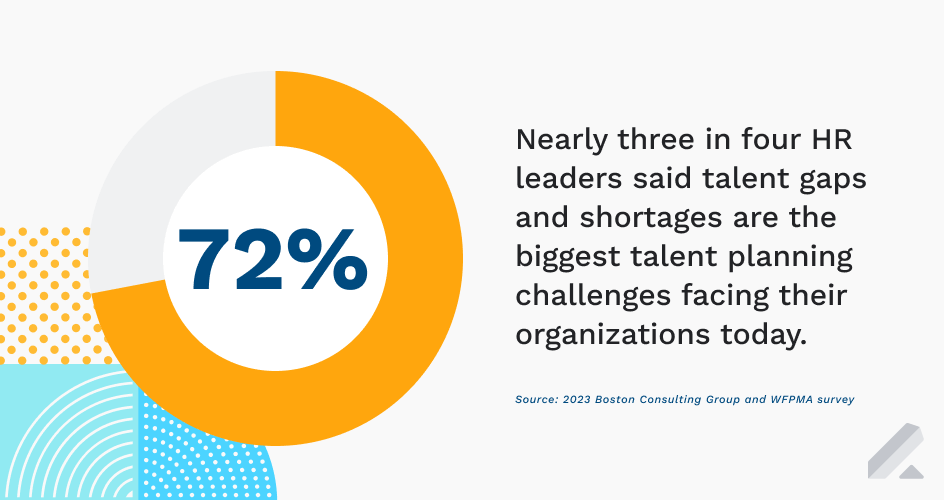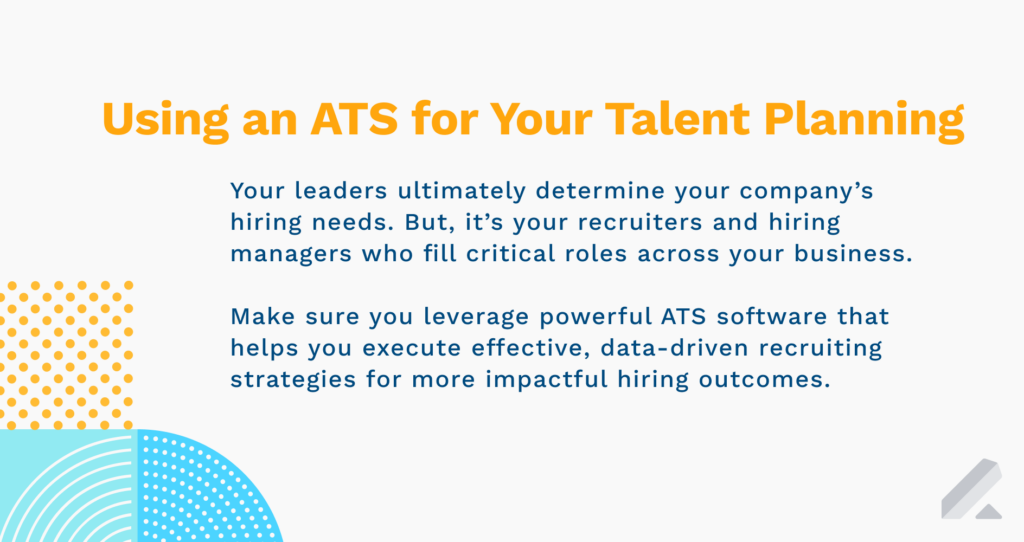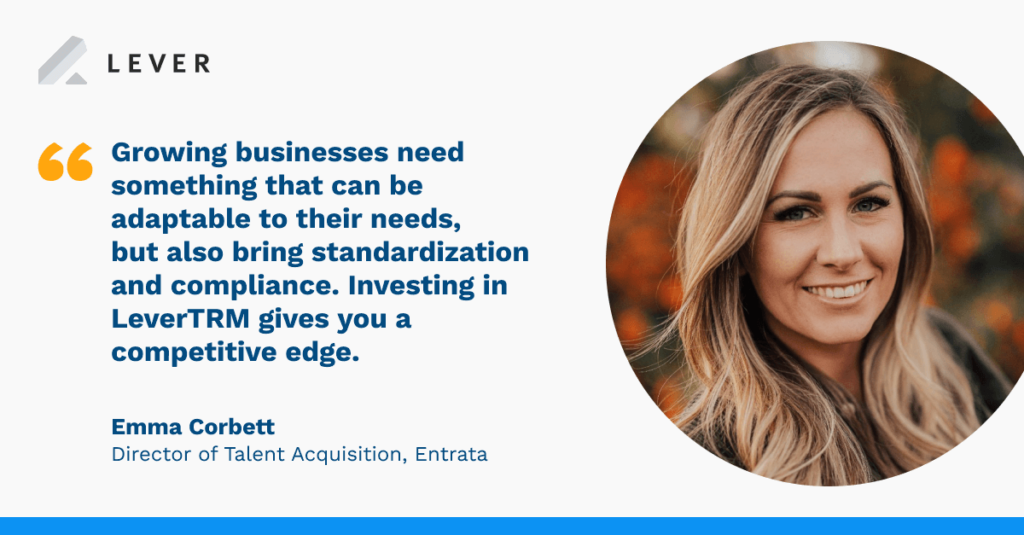Building an annual talent planning strategy involves a lot of moving parts:
- Your leaders analyze workforce data to learn what roles and teams need headcount.
- Your hiring managers share preferences for new and current positions to fill.
- Your talent acquisition leader tells recruiters which requisitions to focus on first.
If your hiring team does its part by executing on this vision, high-performing employees are hired, skills gaps are addressed, and important business goals are achieved.
External factors, including tight labor markets and economic uncertainty, can prevent your hiring team from executing effectively on your leaders’ talent plan.
To deal with these disruptive periods and address your workforce needs, your business must review your current approach to attracting and retaining high-potential employees and make data-backed changes that help you hire smarter and faster.

Reviewing your existing talent planning process
The Future of Recruiting Report from LinkedIn found 69% of recruiters cited the current macroeconomic climate as a big reason for their poor hiring results in 2023.
And yet, many recruiters must still execute the long-term talent strategies from their leaders by attracting, engaging, interviewing, and hiring qualified candidates.
So, how can your company add more highly productive employees when economic conditions are rocky, talent is scarce, and competition for high-quality candidates is high?
It starts with scrutinizing your talent planning approach and determining what changes can be made to help your TA team and hiring managers be more collaborative and productive.
Here are three parts of your talent planning process to examine and optimize.
1) Determine which hiring stakeholders you need to include
Your business leaders are the ultimate hiring decision-makers. But, they’re not the only ones.
Your talent leader and hiring managers also have a say early in the talent management planning process about which roles should be prioritized first and which can wait.
When times are tough, it falls on top leaders to make the final determination about which positions deserve immediate attention. However, they should still ask these other hiring stakeholders to rank the roles they believe should take precedent over others.
Recruiters only have so much time and resources to attract and engage job seekers. So, agreeing on which requisitions to approve initially and which to hold off on makes sense.

2) Identify the key business goals you need to achieve
Speaking of resources, your company has critical goals tied to revenue and profitability. But, that doesn’t mean there is only one way to achieve them, including your hiring goals.
“Time and resources aren’t always going to be available [across your organization],” BriteCo CEO Dustin Lemick wrote for Entrepreneur. “You must constantly ask yourself how to achieve your business goals using different resources.“
Some companies think they need to hire a high volume of employees to help them tackle important growth initiatives, like developing new software products or launch new store locations. Yet, they don’t consider existing employees for job openings.
Ask yourself:
- Do we really need to hire more external talent to take on important projects?
- Or could we engage current team members with relevant skills and knowledge to move to other roles and tackle important assignments tied to growth?
Odds are, there are people at your business who are strong-fit candidates for current or net-new positions you need filled. Turning to in-house options can save you the hassle of having to carry out potentially lengthy hiring cycles and costly onboarding processes.
3) Evaluate the technology used to execute your talent plans
A streamlined hiring solution that eliminates manual work, automates daily workflows, and provides a holistic view of all candidate pipeline activities is how top recruitment teams find, engage, and hire top talent faster.
Lever’s recruiting software for small and scaling companies supports thousands of growing businesses. Our solution helps them streamline their hiring and nurture candidates at scale.
If you don’t have a centralized hiring platform with robust candidate relationship management (CRM) and powerful applicant tracking capabilities, take advantage of slower hiring periods to audit your TA tools and look for better software that can help you hire smarter and faster when hiring picks back up.
“Any tech you onboard should also enable your talent ops manager to evaluate your recruiters’ efforts and offer data-backed recommendations that can enhance their day-to-day productivity,” our How to Adjust Your Recruiting in Times of Uncertainty eBook explained.

How to develop an effective talent planning strategy during periods of uncertainty
Analyzing and improving these strategic components of your talent planning process is the ideal starting point for revamping your talent attraction efforts during down periods. But, to realize your leaders’ hiring vision, you also need to examine and enhance these tactical areas.
Assess your existing workforce and state of your talent pool
Your candidate and employee records may live separately for two reasons:
- 1) Your recruiters need a centralized system where they can store all historical candidate information and communications and reference it as needed to accelerate their hiring efforts.
- 2) Your HR team needs a solution where all employee details can be housed and easily accessed.
But, connecting your ATS and HCM software can give your hiring team a holistic, real-time view of all data tied to candidates and employees. This can help you size up your talent pool. For example, you can see how many top candidates exist for certain teams and roles.
This integrated technology setup can also help you detect certain roles that are likely to open soon based on performance management review insights.
The more that top talent is already in your connected TA-HR technology ecosystem, the less the need there is to source passive candidates and post targeted ads to job boards.

Learn what helps your business attract and retain top talent
There are many qualities active job seekers consider when evaluating potential employers, a recent Employ Quarterly Insights Report found. For example, 52% of candidates said career advancement opportunities were a major factor in their decision to join a company.
Providing career pathing and continuous learning and development programs helps many businesses attract and retain top talent today. Lacking these programs only makes it that much harder for your business to hire qualified candidates and keep them long term.
Other factors that play a role in your ability to attract and retain talent include:
- Progress with diversity, equity, and inclusion and building a strong company culture
- Flexible working options that enable employees to work part- or full-time from home
- Compensation packages, including the salary, bonuses, and commissions you offer
The point is securing candidate feedback can provide insight into their decision-making and give your leaders the chance to implement changes that make your company more desirable when candidates begin to actively look for new job opportunities again.

Connect with and analyze candidates with an advanced ATS
All this legwork culminates in executing your talent planning strategy. That means you must:
- Publish organic postings and paid ads to high-converting job boards and social media
- Proactively reach out to passive candidates on LinkedIn and similar career communities
- Optimize your career site for search engines and with your employer brand messaging
- Add job seeker information to your ATS so you can build unified candidate profiles
This collective recruiting effort means more qualified candidates are added to your talent pool. Those folks can then be engaged by your team at the right time for the right roles.
And with Lever’s powerful recruiting software for scaling organizations, you can do all this right from a single talent acquisition platform, not several disparate hiring and HR tools.
Consider property management software provider Entrata.
The company uses Visual Insights, Lever’s built-in talent analytics, to better understand daily candidate movement across the funnel and share relevant insights with leaders.
Bigger picture, Entrata is also now able to use the recruitment data that dynamically updates in the dozen-plus dashboards in Visual Insights for its strategic talent planning.
“For the first time in Entrata’s history, we can report on global metrics,” said Entrata Director of Talent Acquisition Emma Corbett. “We’ve leveraged that data to build our [talent] strategy for next year. I can confidently say that we were not able to do that prior to Lever.”
Fill critical roles that are part of your company’s workforce plan quickly and efficiently with Lever’s recruiting software for small and scaling businesses. Schedule a demo today.



